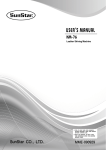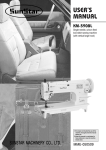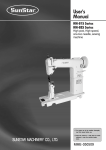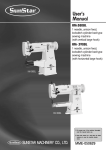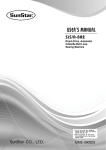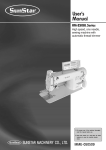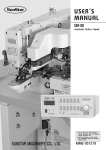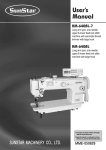Download User's Manual - Casa Almeida
Transcript
R User’s Manual KM-341BL High-speed 1-Needle Lock Stitch Upper/Lower Feed Sewing Machine lity a u tQ Besst Pricevice Be st Ser Be 1. Thank you for purchasing our product. Based on the rich expertise and experience accumulated in industrial sewing machine production, SUNSTAR will manufacture industrial sewing machines, which deliver more diverse functions, high performance, powerful operation, enhanced durability, and more sophisticated design to meet a number of user’s needs. 2. Please read this user’s manual thoroughly before using the machine. Make sure to properly use the machine to enjoy its full performance. 3. The specifications of the machine are subject to change, aimed to enhance product performance, without prior notice. 4. This product is designed, manufactured, and sold as an industrial sewing machine. It should not be used for other than industrial purpose. R Contents 1. Machine Safety Rules ............................................................................................................................ 4 1-1. Transportation .............................................................................................................................................. 4 1-2. Installation ................................................................................................................................................... 4 1-3. Repair ........................................................................................................................................................... 4 1-4. Operation ..................................................................................................................................................... 5 1-5. Safety Devices ............................................................................................................................................. 5 1-6. Location of Warning Marks ........................................................................................................................ 6 1-7. Warning Messages ....................................................................................................................................... 6 2. Entire Configuration ................................................................................................................................ 7 3. Specifications ............................................................................................................................................. 8 4. Installation .................................................................................................................................................... 9 4-1. Where to Install ........................................................................................................................................... 9 4-2. Machine Transportation .............................................................................................................................. 9 4-3. Laying Down Sewing Machine .................................................................................................................. 9 4-4. Returning to Original Position .................................................................................................................. 10 4-5. Installation of Head Part ............................................................................................................................ 10 4-6. Installation of Power Switch Box ............................................................................................................. 10 4-7. Adjusting Belt Tension .............................................................................................................................. 11 4-8. Installation of Belt Cover .......................................................................................................................... 11 4-9. Thread Stand .............................................................................................................................................. 12 4-10. Knee Lifting Pad ..................................................................................................................................... 12 4-11. Oil Supply ................................................................................................................................................ 12 4-12. Inserting Bobbin into Bobbin Case ........................................................................................................ 13 4-13. Test Operation (Pedal Operation) ........................................................................................................... 14 5. Basic Sewing Machine Adjustments .......................................................................................... 15 5-1. Needle Insertion ......................................................................................................................................... 15 5-2. Adjusting Needle and Hook Timing ......................................................................................................... 15 5-3. Adjusting Oil Supply to Hook .................................................................................................................. 16 5-4. Adjusting Lower Thread Spinning ........................................................................................................... 16 5-5. Adjusting Thread Tension ......................................................................................................................... 17 5-6. Adjusting Thread Take-up Spring ............................................................................................................ 17 5-7. Placing Upper Thread ............................................................................................................................... 18 5-8. Adjusting Pressure of Presser Foot ........................................................................................................... 18 5-9. Adjusting Stitch Length ............................................................................................................................ 18 5-10. Adjusting Height of Feed Dog ................................................................................................................ 19 5-11. Adjusting Main and Auxiliary Presser Feet ........................................................................................... 19 6. Errors and Troubleshooting ............................................................................................................. 21 7. Table drawing ........................................................................................................................................... 22 3 Machine Safety Rules Safety instructions in this manual are defined as Danger, Warning and Caution. If they are not properly observed, physical injuries or machine damage might occur. Danger : This mark must be observed. Otherwise, danger could result during machine installation, transportation and operation. Warning : When this mark is observed, machine-related injuries could be prevented. Caution : When this mark is observed, machine errors could be prevented. 1-1) Transportation Danger 1-2) Installation Warning Those, who fully understand the safety rules, should transport the sewing machine. The following instructions must be observed during transportation: At least two people should move the machine. To prevent accidents from occurring during transportation, wipe off the oil put on the surface of the machine. The machine may not work properly or break down depending on where it is installed. The right place of installation should meet the following conditions: Remove the package and wrappings from the top in order. Take a special notice of the nails on the wooden box. Dust and moisture stains and rusts the machine. Install air-conditioners and clean the machine regularly. Keep the machine away from direct sunlight. Leave the left, right and rear sides of the machine at least 50cm away from the wall to secure sufficient space for repair. Explosion Do not use the machine in the atmospheres exposed to the danger of explosion. To avoid explosion, do not operate this machine in a place where a large quantity of aerosol products is used or where oxygen is stored, unless there are specific facilities installed to prevent explosion. The machine does not provide lightings. End users should install them at their workplace. [Note]See “4. Installation” for more details on machine installation. 1-3) Repair Caution 4 When the machine needs to be repaired, only the designated A/S engineers, who were trained by Sunstar, should repair the machine. Before cleaning or repairing the machine, turn off the machine and wait for 4 minutes till the machine is completely discharged. The machine specifications and parts should not be altered without prior consultation with Sunstar. This may pose danger to operation. When repairing, only the original spare parts produced by Sunstar should be used for replacement. Put all safety covers back on the machine after repairing is complete. 1-4) Operation Warning KM-341BL Series is an industrial sewing machine designed to conduct pattern sewing using fabrics and other similar materials. During operation, the following instructions should be kept in mind: Read through this manual carefully and completely before operating the machine. Wear proper clothes for safety. Keep hands or other body parts away from the machine's operating sections (needle, hook, take-up, pulley, etc.), when the machine is in operation. Do not remove safety plates and various covers, while the machine is operating. Be sure to connect the machine to the grounding conductor. Turn off the machine before opening the electric boxes including the control box. Make sure that the power switch is "OFF". Stop the machine when placing a thread or when checking swing materials. Do not turn on the machine when stepping on the pedal. If possible, install the machine away from the place where powerful electromagnetic waves are generated, such as high-frequency welding machine. [ Warning ] Make sure that the motor cover is closed during machine operation. Turn off the power when checking or adjusting the machine. 1-5) Safety Devices Safety label : Shows the cautions users should keep in mind during operation Take-up cover: Prevents human body from contacting thread take-up Belt cover: Prevents physical injuries from occurring by the belt or clothes from being stuck in the belt. Power specification label: Displays safety cautions to prevent electrification (Power input and use Hz) Caution 5 1-6) Location of Caution Marks Caution marks are attached on the machine for safety. When operating the machine, carefully read the instructions on the mark. 1-7) Warning Messages Caution 1) 2) 6 Entire Configuration Arm Bed Oil Fan Face Plate Top Cover Oil Window Presser Foot Knee Lifting Pad Power Switch Reverse Lever Stitch Dial Pulley Thread Stand Safety Devices Take-up Cover Belt Cover 7 Specifications MODEL KM-341BL Name High-speed 1-Needle Lock Stitch Upper/Lower Feed Sewing Machine with Vertical Large Hook Needle in Use DP 17 #23, DB 1 #21 (#20 ~ #24) Needle Stroke 34.7 mm Thread Take-up Stroke 71.5 mm Up/Down Overlap of Presser Foot 2 ~ 5 mm Hand 8 mm Knee 14 mm Presser Foot Lifting 8 Max. Fabric Thickness 8 mm Max. Thickness of Fabric End 5 mm Feed Dog Height 1~1.2 mm Application Medium ~ Heavy Materials Installation [ Caution ] Sewing machine installation and wiring work should be conducted by qualified engineers. Since the sewing machine's body weights 50kg or so, at least two persons are needed to install the sewing machine. Do not turn on the power until the installation is completed. If the foot pedal is accidentally stepped, the sewing machine can start operation, providing causes for accidents. When the sewing machine body is laid down or erected straight, use both hands. If only one hand is used, it may cause injuries such as fingers stuck in the machine. 4-1. Where to Install 1) Do not install the sewing machine next to television, radio and wireless phones, since they can cause noises to the sewing machine. 2) Connect the power plug of the sewing machine directly to the AC outlet. If a multi-tap is used, it may cause malfunction of the sewing machine. [ Fig. 1 ] 4-2. Machine Transportation 1) The body of the sewing machine shall be transported by two persons as in the figure. [ Fig. 2 ] 4-3. Laying Down Sewing Machine 1) Hold the upper part of the sewing machine body with two hands and lay it down by pushing it backward. Then the sewing machine lies down. Make sure that press the lower part of the plate leg of the sewing machine. Otherwise, the sewing machine body and the entire plate leg might fall backward, causing accidents. [ Fig. 3 ] 9 4-4. Returning to Original Position 1) Clear away tools from the table. 2) Hold the face plate with the left hand, while slowly returning the sewing machine back to its original position. [ Fig. 4 ] 4-5. Installation of Head Part Insert the hinge rubber into the table, and insert the oil fan into the middle of the head supporting rubber B as in Fig. 5. Insert the head hinge into the bed hole and install the machine above the head supporting rubber A and the head supporting rubber B , while inserting the hinge rubber . [ Fig. 5 ] 4-6. Installation of Power Switch Box See <Fig.6> when installing the power switch box install it on the right bottom of the table. and [ Fig. 6 ] 10 4-7. Adjusting Belt Tension 1) When looking at the sewing machine from the pulley side, it looks like it is spinning in the left side. 2) To adjust the belt tension, press the belt with a finger and when it is pushed down about 15~20 mm, fasten the nut . Keep the presser foot stay at the up position, while the belt is spined for testing. [ Fig. 7 ] 4-8. Installation of Belt Cover 1) Attach the belt cover A to the sewing machine body using the screw (3EA) and three belt supports . If the sewing machine is pushed backward a little bit, assembling the belt cover A becomes a bit easier. When the assembly of the belt cover A is finished, insert the front part of the belt cover C into the groove of the belt cover A , and fix the rear part using the screw . 2) Attach the belt cover B to the table. Make sure that the belt cover B does not interfere with the belt operation. [ Fig. 8 ] [ Fig. 9 ] 11 4-9. Thread Stand 1) Install the thread stand on the table as in the figure. [ Fig. 10] 4-10. Knee Lifting Pad 1) Attach the knee lifting pad to the bottom of the oil fan as in the figure, and fasten it using the bolt . 2) Loosen the bolt to adjust the position of the knee lifting pad for user's comfortable operation. [ Fig. 11 ] 4-11. Oil Supply [ Caution ] When oil supply is completed, do not plug in the sewing machine. When the sewing machine is plugged in, and the pedal is accidentally stepped on, the sewing machine might start, causing injuries. When dealing with lubricant, wear glasses and gloves to protect eyes and hands. Take caution not to make eyes and skin contact lubricant. When lubricant is touched, rinse off the smear with a soap and running water. When lubricant touches eyes, rinse off lubricant in running water and go to hospital to see a doctor. Do not swallow lubricant. It may cause diarrhea and vomiting. If you swallow lubricant, immediately see a doctor. Keep lubricant out of reach of children and youth. Keep lubricant stored away from fire. When it is first time to operate the sewing machine or it is reuse of the sewing machine after a long-term storage, please supply oil to the machine. Use original Sunstar lubricant (Lubricant is in the accessory box). A. Installation of Magnet Removing Chips (Iron Powder) Attach the magnet removing chips (iron powder), which is inside the accessory box, to the oil pump inside the bed. Do not remove the magnet to use it for other purpose. If the sewing machine is operated without the magnet, it may cause malfunction in the machine and negatively affect durability of the machine. 12 B. Lubricant Supply to Oil Fan a) Fill lubricant up to “High”. b) Use the oil for Sunstar industrial sewing machine or Shell’s Tellus C10 as lubricant. c) When lubricant reaches “Low”, lubricant should be resupplied until it reaches “High”. d) Exchange lubricant oil every two weeks. Magnet Oil pump [ Fig. 12 ] [ Fig. 13 ] 4-12. Inserting Bobbin into Bobbin Case 1) Insert the bobbin into the bobbin case as in the figure below. If the bobbin is inserted in the opposite direction, it is spined loosely, causing entanglement of lower thread. 2) Insert the thread into the lower thread tension adjusting spring through the thread path and take out the thread through the thread hole . 3) Set the output tension to the extent that when the bobbin case is dropped with the end of the thread held, it falls gradually. 4) When the tension adjusting screw is turned clockwise, the lower thread tension gets stronger. When it is turned counterclockwise, the lower thread tension gets weaker. Weaker Stronger [ Fig. 14 ] 13 4-13. Test Operation (Pedal Operation) [ Caution ] During operation, do not touch spinning or moving parts or press them with an object. It may cause physical injuries or machine breakdowns. 1) Move the pedal at the B position to see if you can conduct low speed sewing. 2) Move the pedal at the C position to see if you can conduct high-speed sewing. 3) Step the pedal (B or C position). Stay your feet away from the pedal and place it at the Neutral A position. Check whether the needle stops below the surface of the needle plate (in case of setting up the lower stop position). [ Fig. 15 ] 14 Basic Sewing Machine Adjustments 5-1. Needle Insertion Place the long groove of the needle toward the left. Insert the needle deep into the needle bar hole and fasten the needle fixing screw . [ Fig. 16 ] 5-2. Adjusting Needle and Hook Timing 1) Needle Bar Lifting Turn the pulley to place the needle 2.24mm above the lowest point. In this case the hook point and the middle of the needle should be aligned. Loosen the fixing screw and set the hook point at the middle of the needle . Adjust the distance between the hook point and the needle at 0.05~0.1mm. [ Fig. 17 ] 2) Needle Bar Height Loosen the tightening screw to adjust the distance between the upper part of the thread hole and the hook point at 0.5~1.5mm when the hook point is aligned with the middle of the needle . Move the needle bar up or down to adjust the needle bar and fasten the screw . [ Fig. 18 ] 15 5-3. Adjusting Oil Supply to Hook Turn the oil volume adjusting screw , which is inserted in the lower shaft front bushing, clockwise( ). It will release more oil. Turn the screw counter-clockwise( ) and it will release less oil. Less More [ Fig. 19 ] 5-4. Adjusting Lower Thread Spinning [ Fig. 20 ] 1) 2) 3) 4) Insert the bobbin into the thread spinning shaft . Press the thread spinning lever . Spin five or six times by hand in the direction of thread spinning in the bobbin and operate the sewing machine. If the thread spinning does not take place horizontally, loosen the thread guide screw and move the thread guide plate left or right for adjustment. 5) When the thread is spun around the bobbin a lot, loosen the adjusting screw . When the thread spun around the bobbin is small, fasten the screw. 16 5-5. Adjusting Thread Tension Weaker Stronger [ Fig. 21 ] 1) Adjust the lower thread tension by slightly turning the tension adjusting screw , so that when the end of thread is picked up by hand, the thread does not get loose. The average tension of pulling the thread out of the bobbin case is 30~50g. 2) Lower the presser foot and turn the tension adjusting screw to adjust the upper thread. 5-6. Adjusting Thread Take-up Spring Large Small [ Fig. 22 ] 1) The scope of operation of the thread take-up spring is 7~10mm. The standard strength of the thread take-up spring twist is 40~60g. 2) When adjusting the scope of operation of the thread take-up spring, loosen the fixing screw for the thread take-up and turn the thread adjusting device (Adjust the scope of operation to be smaller for heavy materials and vice versa for light materials.) 3) Adjust strength of the thread take-up spring by inserting a driver into the groove of the thread adjusting device post and turn it left or right (Adjust strength of the thread take-up spring to be stronger for heavy materials, and vice versa for light materials.) 17 5-7. Placing Upper Thread [ Fig. 23 ] 1) Move the thread take-up to the highest position. 2) Insert the thread into the needle from left to right. 5-8. Adjusting Pressure of Pressor Foot Loosen the fixing nut for the pressure adjusting screw and turn the pressure adjusting screw left or right to make the sewing fabric held by the pressor foot. Fasten the fixing nut . [ Fig. 24 ] 5-9. Adjusting Stitch Length 1) Match the desired number on the stitch length dial with the pin above. The bigger the figure becomes, the bigger the stitch length becomes. 2) Press the reverse lever by hand for reserve sewing. This time, the sewing fabric is fed in the opposite way. When the reverse lever is not pressed, the sewing fabric is fed in the normal direction. [ Fig. 25 ] 18 5-10. Adjusting Height of Feed Dog When the stitch length is maximum and the feed dog is above the needle plate, the maximum height of the feed dog is 1~1.2mm. Loosen the screw and move the feed lift shaft crank left or right to adjust the height of the feed dog. [ Fig. 26 ] 5-11. Adjusting Main and Auxiliary Presser Feet 1) Alternative Longitudinal Move of Main and Auxiliary Presser Feet The main presser foot and the auxiliary presser foot move up and down alternatively. When the main presser foot and the auxiliary presser foot are at the highest position respectively, their heights should be same or the height of the auxiliary presser foot should be a bit lower. Place the thread take-up at the lowest position and pull down the presser bar lift . Loosen the screw and adjust the longitudinal movement adjusting crank left or right (When it is moved to the left, the lift of the auxiliary presser foot grows smaller.) Left Right Uniformity height [ Fig. 27 ] 19 2) Longitudinal Operation Range of Main and Auxiliary Presser Feet [ Fig. 28 ] The longitudinal operation range of the main presser foot and the auxiliary presser foot range from 2 to 5mm. Loosen the nut according to the sewing fabric and adjust the presser foot longitudinal movement shaft up or down. When the sewing fabrics have only small gaps in thickness, the operation range should be set at the minimum level. (highest position: 5mm, lowest position: 2mm) 3) Adjusting Front/Rear Location of Main Presser Foot Set the stitch length at the maximum figure and loose the screw to the extent that the rear side of the auxiliary presser foot is not contacted with the main presser foot . Move the horizontal movement adjusting crank for the presser foot left or right for adjustment. Gap [ Fig. 29 ] 4) Adjusting Feed of Main Presser Foot The standard ratio of the feed dog feed to the main presser foot feed is 1:1. Depending on sewing conditions, the feed volume of the main presser foot can be different. Loosen the nut and move the horizontal movement adjusting shaft for the presser foot up or down. Small Large [ Fig. 30 ] 20 Errors and Troubleshooting 1) Troubleshooting NO. Error Needles are broken. Thread is broken. Thread tension is improper. When sewing starts, the upper thread is escaped or sewing skip occurs. Check Cause Handling Measure Direction and height of needle insertion The direction of inserting a needle is wrong. Insert the needle in a right direction and push it into the deepest position. Needle A needle is crooked. Replace the needle. Feed dog timing The feed dog timing for needle bar movement is bad. Adjust the timing of feed dog. Lifting of needle bar The timing of needle and hook is bad. Adjust the timing of needle and hook. Height of needle bar The timing of needle and hook is bad. Adjust the timing of needle and hook. Gap between needle and hook The timing of needle and hook is bad. Adjust the timing of needle and hook. Method of thread placing The thread placement is wrong. Place the thread in the right way. Needle The needle is crooked/The tip of the needle is broken. Replace the needle. Direction, height of needle The direction of the needle is wrong. Insert the needle in the right way. Upper thread tension The upper thread tension is too strong. Adjust the upper thread tension properly. Lower thread tension The lower thread tension is too strong. Adjust the lower thread tension properly. Movement range of thread take-up spring The movement range is too wide. Adjust the movement range of the spring. Thread tension The upper and lower thread tension is improper. Adjust the upper and lower thread tension. Tread take-up spring tension The tread take-up spring tension is improper. Adjust the tread take-up spring tension. Gap between opener and hook The gap between opener and hook is improper. Adjust the gap between opener and hook. Direction, height of needle The needle position is wrong. Insert the needle in the right direction. Needle A needle is crooked/ The end of the needle is broken. Replace the needle. Placing the thread How to place thread is wrong. Properly place the thread. Gap between needle and hook The timing of thread and hook is improper. Adjust the timing of thread and hook. Check the highest needle stop position Reset the position of the needle's Because the needle's highest stop highest stop position. position is not proper, the thread take-up removes the upper thread by pulling it when the sewing starts. 21 Table Drawing 22






















